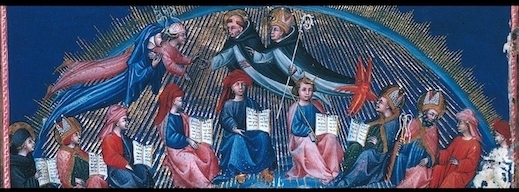A imagem trina de Deus no homem no De Trinitate de Agostinho
Palavras-chave:
Deus, unidade, trindade, tríade, mente, amor, conhecimento, God, unity, trinity, triad, mind, love, knowledgeResumo
Propõe-se analisar as tríades agostinianas compostas pelo amante, amado e amor, e pela mente, conhecimento e amor, presentes na mente e descritas no livro IX da obra A Trindade (De Trinitate) de Agostinho. Ambas assemelham-se à Trindade Divina, são unas e trinas simultaneamente, segundo a imagem e semelhança do homem em relação a Deus (cf. Gn 1, 26). Agostinho parte da afirmação: “Deus é amor” (I Jo 4, 8) e complementa: “se vês o amor, vês a Trindade” (De Trin., VIII, 8, 12). A mente, sendo capaz de direcionar a si o amor, desdobra-se da unidade à tríade composta por amante, amado e o próprio amor, que evidencia a imagem divina, mas não a retrata fielmente. Então, para que isso seja possível, intercala o conhecimento ao amor. O amor é posterior ao conhecimento e provém de ambos. O conhecimento não é inferior à mente, se esta se conhece na medida de todo o seu ser. O mesmo se pode dizer do amor, desde que a mente se ame na mesma proporção em que se conhece. A unidade da mente dá origem à tríade: mente, (auto)conhecimento e amor, imagem da Trindade Divina. Os três componentes são iguais entre si, possuem cada qual sua substância e coexistem em uma mesma essência. Remetem à unicidade e à Trindade Divina, e estão presentes na essência humana. /// A proposal is made to analyse the Augustinian triads composed of lover, beloved and love, and of mind, knowledge and love, present in the mind and described in Book IX of Augustine’s The Trinity (De Trinitate). Both resemble the Divine Trinity, they are simultaneously one and triune, according to the image and likeness of man in relation to God (cf. Gn 1:26). Augustine starts from the affirmation “God is love” (1 Jn 4:8) and complements it: “If you see love, you see the Trinity” (De Trin., VIII, 8, 12). The mind, being capable of directing love to itself, unfolds from unity to the triad composed of loved, beloved, and love itself, which evinces the divine image, but does not portray it faithfully. Therefore, for this to be possible, knowledge is merged with love. Love is posterior to knowledge, and issues from both, mind and (self )knowledge. Knowledge is not inferior to the mind, if the latter knows itself to the measure of its whole being. The same can be said of love, provided that the mind loves itself with the same proportion that it knows itself. The unity of mind gives origin to the triad: mind, (self )knowledge and love, image of the Divine Trinity. The three components are equal among themselves, they each possess their own substance and coexist in one same essence. They trace back to the Divine unity and Trinity and are present in the human essence.Edição
Seção
Articles






